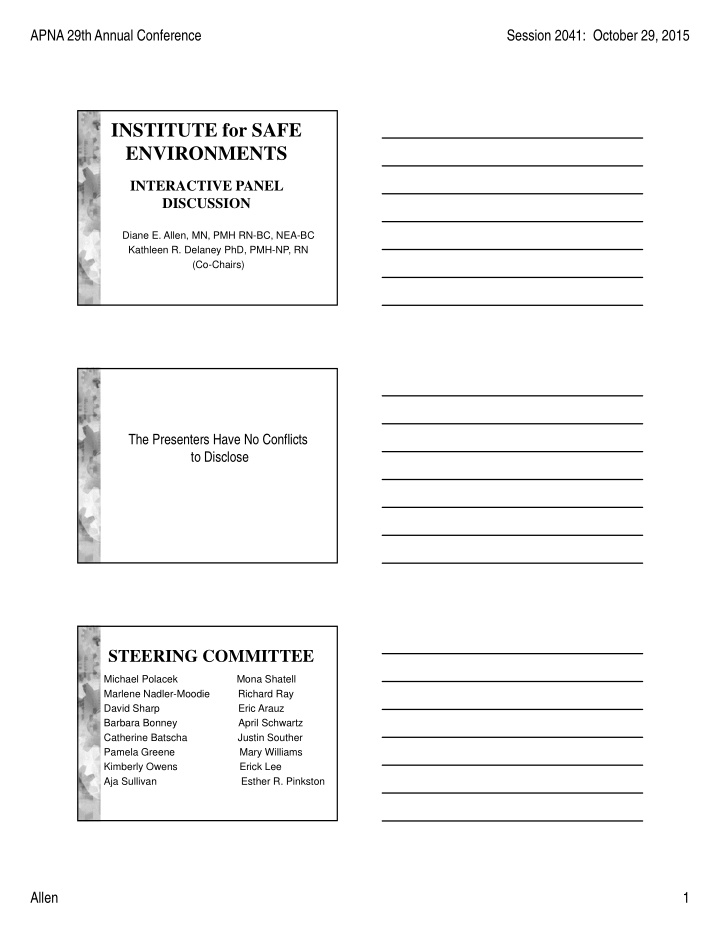



APNA 29th Annual Conference Session 2041: October 29, 2015 INSTITUTE for SAFE ENVIRONMENTS INTERACTIVE PANEL DISCUSSION Diane E. Allen, MN, PMH RN-BC, NEA-BC Kathleen R. Delaney PhD, PMH-NP, RN (Co-Chairs) The Presenters Have No Conflicts to Disclose STEERING COMMITTEE Michael Polacek Mona Shatell Marlene Nadler-Moodie Richard Ray David Sharp Eric Arauz Barbara Bonney April Schwartz Catherine Batscha Justin Souther Pamela Greene Mary Williams Kimberly Owens Erick Lee Aja Sullivan Esther R. Pinkston Allen 1
APNA 29th Annual Conference Session 2041: October 29, 2015 OBJECTIVES Describe goals of ISE and this year’s efforts to inform APNA members about safety related issues. Engage APNA members in discussions about risks associated with providing patient care for individuals with mental illness. Identify current safety-related concerns of APNA members. INSTITUTE for SAFE ENVIRONMENTS Vision The Institute for Safe Environments provides an integrated structure designed to thoughtfully address issues that impact the safety of persons served as well as service providers. INSTITUTE for SAFE ENVIRONMENTS Goals Identify issues related to safe 1. environments Explore current evidence related to 2. issues Recommend strategies to promote 3. safe, evidence-based, best practices Allen 2
APNA 29th Annual Conference Session 2041: October 29, 2015 KEY ELEMENTS of a SAFE ENVIRONMENT Culture and Idealogy Engagement Emergency Management Patient assessment and monitoring Staff resources, education and training Space and equipment Error Prevention Rules Physical Risks FOCUS of ISE WORK 2014-2015 Engagement Emergency Management Allen 3
APNA 29th Annual Conference Session 2041: October 29, 2015 MEMBER BRIDGE “HOT SAFETY TOPICS” 2014-2015 WHAT’S ALLOWED vs. NOT ALLOWED Belongings - Contraband Activities - Restrictions Behaviors - Controls ROLE of PSYCHIATRIC NURSES in HOSPITAL EMERGENCY DEPARTMENTS MARLENE NADLER-MOODIE MEMBER SURVEY WORKGROUP Michele Heyland Gale Sullivan Christine Tebaldi Colleen Robinson Babette Wieland Camille Kennedy Michael Polacek Jeannine Loucks April Schwartz Kelly Southard Allen 4
APNA 29th Annual Conference Session 2041: October 29, 2015 Background ISE Member Interest What is role of PMH nurse in the ED? Who is best at providing care in the ED? What skills are best suited Training and Competency Survey Design 25 items Conducted March 23 to April 23, 2015 Email link to 10,000 APNA members Requested forwarding to others Results 520 respondents/ 468 completed 60% identified as a Psychiatric Nurse 31% identified as an ED Nurse 40% employed as RN > than 20 years 39% held BSN Allen 5
APNA 29th Annual Conference Session 2041: October 29, 2015 Age Demographics Vast majority- older: 51-60 = 31% 31-40 = 20% 41-50 = 18% 20-30 year olds only 12%: Workforce is aging out, need young recruits Settings 58% Urban 26% Suburban Majority = ED in general hospital with a designated psychiatric treatment area Definition of Role 42% “Psychiatric Emergency Department Nurse” 28% “Emergency Department Nurse” 42% “Crisis Management” is psychiatric nurse’s primary role 33% Liaison expert Allen 6
APNA 29th Annual Conference Session 2041: October 29, 2015 Education, Training, Competency 85% required to demonstrate competency in caring for patients with medical diagnoses 52% required to demonstrate competency regarding psychiatric issues (48% no requirement for psychiatric issues) Conclusions and Recommendations High degree of interest among PMH nurses about the care of patients in ED Agreement on Job Title: Psychiatric Emergency Department Nurse Primary role is “crisis management” Currently well educated, active work force that will age Conclusions and Recommendations Recruitment focus on younger 20-30 year olds Education offerings in both emergency medical care and psychiatric care should be available Opportunities: Exploration of a subspecialty Focused education Competency Demonstrations Specialized Certification Allen 7
APNA 29th Annual Conference Session 2041: October 29, 2015 MEMBER BRIDGE HOT SAFETY TOPICS HOW TO MONITOR FOR SAFETY? Safety Rounds 1:1 Sitters Constant Observation CONTINUOUS SPECIAL OBSERVATION RICHARD RAY CONTINUOUS SPECIAL OBSERVATIONS INHERENT PROBLEMS • Control and coercion • Restriction in privacy • Symptom exacerbation • Unit safety • Counter-therapeutic aspects • Staff productivity Allen 8
APNA 29th Annual Conference Session 2041: October 29, 2015 MEMBER BRIDGE HOT SAFETY TOPICS HOW TO STAY SAFE WHILE PRACTICING RELATIONSHIP- BASED NURSING? ENGAGEMENT & SAFETY MICHAEL POLACEK ENGAGEMENT TOOLBOX www.lumaxart.com/ Allen 9
APNA 29th Annual Conference Session 2041: October 29, 2015 INSTITUTE for SAFE ENVIRONMENTS OUR HOPES for the FUTURE and WHY WE NEED YOUR HELP! INSTITUTE for SAFE ENVIRONMENTS YOUR HOPES for the FUTURE? How can we better serve your needs? How can ISE best respond to hot topics? COMMENTS and QUESTIONS? Allen 10
Recommend
More recommend